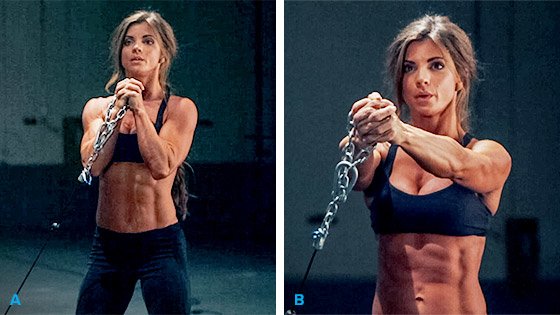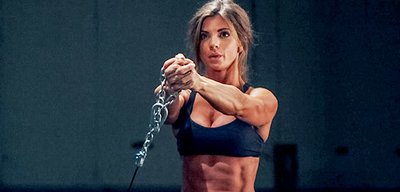Core training is like the fitness world's version of Kevin Bacon. Just like every actor is always six or fewer Hollywood connections from the star of "Footloose," you're never ever more than a few clicks from an article or video that promises to deliver be-all end-all info about abs training. Once Facebook and Google have figured out that you have the slightest interest in strength or training, the number goes down to one—as in, the same ad over and over again.
This speaks to how much people like defined abs, of course, but to me, the analogy doesn't end there. The core itself is also kind of like Mr. Bacon, because it plays a role in pretty much every movement we do inside the gym and out. If you ever doubt this, just go strain an abdominal muscle, and tell me how many times a day you get painfully reminded of it.

Pallof Press
Normally, this is the point in the article where an author tells you never to do another crunch or sit-up. I won't. To be honest, there are certain situations where they're perfectly appropriate. However, as my good friend, strength coach Mike Robertson, CSCS, has noted on several occasions, if flexion (bending forward) were the primary motion abdominals were designed to perform, they'd be called hamstrings.
So, do you need to train your core every day and in every way to build strong abs? No thanks. Instead, start by integrating the one exercise we use with almost everyone we work with at my gym, Cressey Performance, from pro athletes to the general public. Meet the Pallof press!
Stabilization Is Strength
If you look at the muscular anatomy of the core—which, to be clear, is pretty much everything except your limbs—you can clearly see varying muscle-fiber pennation, as well as a crosshatched, web-like appearance of the connecting tissue. It's sort of like a woven basket, but one solid enough that it could hold anything without spilling.
This clearly implies that the core's true functions have to do with stability more than movement. It resists trunk extension (bending backward), helps bring the hips into a strong posterior pelvic tilt position, and keeps your precious guts and spine from sloshing around dangerously when you're rotating.
The bulk of the core exercises I recommend are those that mirror this mindset. While a good trainer always approaches clients on a case-by-case basis, and considers each person's goals, needs, injury history, and postural considerations, I have yet to meet anyone who couldn't benefit from more core stability. And the Pallof press is the perfect way to build it.
Named after Boston-based physical therapist John Pallof (one "f," not two), who first introduced the exercise to me back in 2006, the Pallof press also happens to be one of the more user-friendly exercises out there. It can be regressed down to the level where anyone can do it. Just as importantly, it can be scaled upward to challenge anyone who thinks they're too advanced for it.
In this video, I describe the exercise in more detail, as well as the most common mistakes I see when people perform it.
After viewing and trying the Pallof, you've probably got the basic version down with a weight that's challenging but not form-compromising. Great—now what? Don't rush to move the pin up the stack. You'll quickly reach a point where the downside is greater than the benefit. Instead, tweak the movement itself to make it more challenging and less stable.
Here are some of my favorite variations:
Tall Kneeling Pallof Press
The objective here is to stay "tall" and to squeeze the glutes hard. Your butt shouldn't stick out.
Half-kneeling Pallof Press
Now we're getting unstable. Squeeze the glute of the trailing leg as hard as you can to promote more posterior pelvic tilt. You'll need those hips and glutes locked in tight to stay steady here, and your core activation will leap up with them.
Standing Split-Stance Pallof Press
Moving from kneeling to standing makes the exercise harder, because you have to control more joints. Assuming a split stance makes it even more challenging because you lessen your base of support. Here, the torso and pelvis shouldn't move at all. Stay as upright and still as possible throughout.
Pallof Press ISO Walk-Out
The simple act of taking a step adds a challenging dynamic element into the mix. I like to tell people to pretend that their hips are headlights and that they should stay as level as possible. No teeter-tottering!
Vertical Pallof Press
Grab the rope attachment and prepare for someone to ask you "So, does that, like, work the delts?" Otherwise, keep the same tension you use in the other variations. The difference here is that the pull from behind will force you to resist extension, not just rotation.
Lateral Pallof Press
Coach Nick Tumminello cooked up this great press variation to help resist lateral flexion, which makes the exercise even more multidimensional.
Hold It Right There
So, where do you start? Just start. Try a couple sets of 8-10 reps at the end of any workout. When that feels easy, do the same but with an isometric hold of somewhere between 2-10 seconds. Making this a dedicated part of your program can help you achieve whatever you're aiming for in the gym, and if you're a coach you can easily customize it to fit the needs and abilities of each individual. Even Kevin Bacon.

